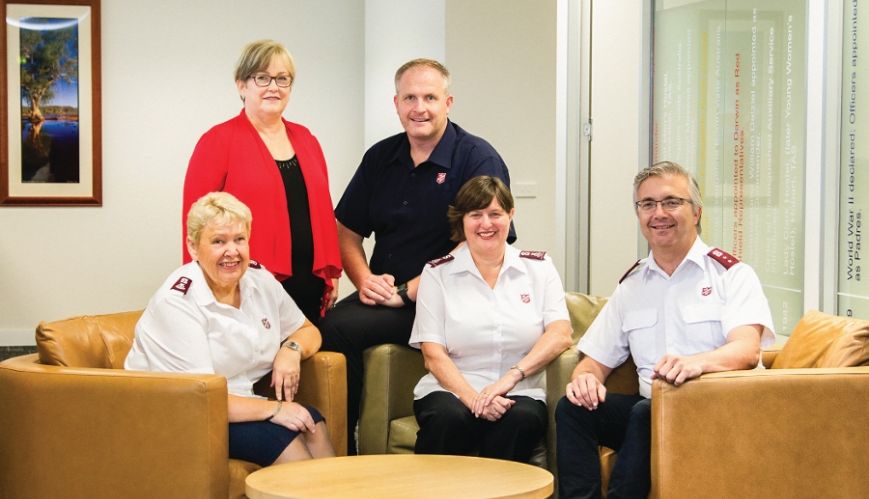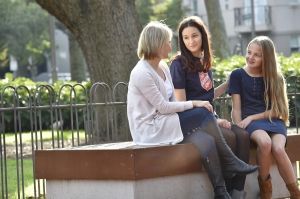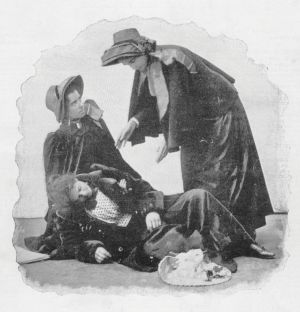All on the same page

All on the same page
12 June 2018
National Secretary for Mission, Lieutenant-Colonel Lyn Edge (front second from left), with her department heads (from left) Major Jenny Begent, Dr Elli McGavin, Captain Steven Smith and Captain Stuart Glover.
By January 2019, the Australia Territory is due to be fully operational.
The four new Mission Department heads have sat down to talk about where The Salvation Army is at, and where it is heading. Asked if the Mission Department was now working though a national approach, or was settling on a “two territories” approach (hanging on to diverse territorial frameworks from the old Eastern and Southern territories), the answer from Major Jenny Begent is clear. “We’re looking at a national approach,” she answers, clearly and firmly. “And ... the sooner the better; the sooner we are all on the one page, the better off we’ll be.”
So, while there are territory-specific issues coming out of last year’s Diversity* conference, for example, such as a practitioner’s understanding of the concept of “intersectionality”**, they do hold national implications when it comes to implementation.
“Practice is important,” Major Begent explains, “right across the nation. I would want us to have a collegiate and coordinated approach to the way we do business, whether we do it in Toowoomba or Wagga Wagga or Broome or Hobart. You want to be able
to walk through any service The Salvation Army runs and receive a service that is holistic but kind, caring, welcoming and open ... where the individual is treated with respect.”
To help us achieve that, Dr Elli McGavin says, The Salvation Army needs “to decide what type of advocacy we want to do, and then understand the participant’s, or client’s, voice a bit better. We can then link that voice with other information. We have some good advocacy out there being done locally. Some of it is quite sophisticated, but currently it is in isolation, so certainly a lot more coordination across the country will be helpful.”
At National Headquarters in Melbourne, and throughout the country, there is a great deal of active learning and mapping going on. There is also much discussion about how we, The Salvation Army, want to treat people; what it wants to do and what it wants to say.
“We want to build on where we are strong and focus our energy into what we want to be known for in transforming Australia,” says Captain Steven Smith. “Key to this is understanding how we can best facilitate holistic mission for the whole person, in our local communities. This needs to guide our decisions and everything we do.”
HOLISTIC MISSION
All four Mission Department heads understand the importance of aiming for holistic mission. “I’m not sure that ‘mission’ can be differentiated between what Jenny’s responsible for – some of the stuff that’s large, chunky social mission – and the way we engage with the community in a local corps-based setting, or through a Doorways-based program***,” says Captain Stuart Glover.
“For me,” he continues, “mission is mission. We express it in different ways. Sometimes it looks like a faith-based expression. Sometimes it looks like a social expression. But we need to get away from the language of a corps-based or faith-based expression of mission versus a social expression of mission. That’s why the department is named the Mission Department. Part of the national transition journey idea is that the silos are broken down, so we are meeting the community at their point of need.”
The point of need in Australia is becoming wider. The Salvation Army has an increasing client base, with expanding client need, ageing and diminishing internal membership, reduced programs and changes to the specificities of federal and state funding models.
In many sectors of social engagement, Major Begent notes, there are large-scale changes designed to empower individual clients; yet the same changes and proposed additional changes (read funding cuts) are placed in a punitive setting and process that lies within “the context of the current government rhetoric around what it means to be able to work [which] sees unemployment as the fault of the person who is out of work, rather than the fault of a wider structure.” 
As well as its own ongoing dynamics of the national transition journey, The Salvation Army is floating in a sea of social welfare reforms that threatens to return to the old 19th-century philosophical model of the “deserving poor and the undeserving poor”. At such a time, The Salvation Army needs to meet people at their point of need, through a holistic, unified approach that comes from the heart of the Army and shares Salvo mission through compassionate community engagement.
Knowing who it is as an organisation, who it aids and who it represents in advocacy, feeds into deeper philosophical and theological questions. Do “the Salvos” have a unique place in the church universal, characterised by St Paul as “the Body of Christ”? “We need to acknowledge we put frail words around all of these things, and metaphors only go so far,” says Captain Smith. “The Spirit of God is living and active in the world, sustaining everything, the body of Christ metaphor is more dynamic and living, and so too is the role we play in transforming Australia, alongside others.
“What we have been is not necessarily what we should return to; I don’t think that what we have been in the past is necessarily always relevant, either. We essentially are an engaging, listening people. People resonate with the heartbeat of The Salvation Army, and that resonance is something that is quite important to me. “What I really love about our International Mission Statement is that it says we are a part of the Body of Christ. We are one part of a whole, and we cannot be holistic in our own right ... to remain relevant, we need to continually ask ourselves, what is the Body of Christ doing? What is the function and value with which we are connecting?”
BODY OF CHRIST
Captain Smith, acknowledging the activist history and theology of The Salvation Army, doesn’t believe it is our place to self-identify as “the hands and feet” of Christ. That way, perhaps, lies hubris or self-limitation. This may seem esoteric to some, but the creative tensions at play in this discourse are important to the decisions made by leadership. Who are we? What’s our role? Why do we choose what to do, and how to do it?
“The Body of Christ thing is a mystery,” says Captain Glover, “and to try and define our role, with hard boundaries, is almost impossible. God calls people and denominations into being for a particular point in time and space. It’s not just a question for us; it’s a question for all organised religion in a Christian sense. I would argue that churches need to relisten, rehear and relearn, or they die. The Spirit of God goes where the energy is. If we don’t respond, then we dissipate.”
Major Begent also wades into this conversation. “[The Army’s founders] Catherine and William Booth were very clear that they did not want to be part of the established Christian church,” she notes. “And over the years, particularly in the Australia Southern Territory, we have evolved our thinking and practice on some issues – that is a healthy thing. 
I quite like the idea that we are a bit more fluid, and maybe we don’t always belong to an established view of the church. It appeals to the rebel in me. I agree that, in terms of where we sit in the wider church, that we are part of the whole, but not the whole.”
The Salvation Army is not called to solve all the world’s problems, nor is it positioned to serve as the sole arbiter of wisdom. It is, however, called to serve God and humanity. In what capacity, and in which sectors, is an ongoing conversation. Of course, seeking to change the world, one person at a time, is not without its complications and risks.
As Captain Smith notes, “We are a pretty big organisation and we do a lot of stuff, with more risk, probably, than we recognise. Navigating that national momentum and national opportunity is challenging, but the opportunity is worth it. Embracing risk is just the new norm; so, it is not an excuse for not advancing. It is something we have to learn how to do; to find our courage and our heart amidst the challenges.”
“One of the risks is not taking everyone with you on a journey like this,” adds Dr McGavin. “We see things happening on a daily basis, but it can be much more difficult for somebody else, sitting somewhere else, to engage with it and be brought along with the changes. That is one of the risks.
“I also think that the national transition journey, this process, has more people excited about it than anything I have ever seen. Its time has well and truly come. We see the value of it and it is an easy sell to people. Engaging everyone in that process is one of the things I want to be sure to do.”
OVERARCHING VISION
For Captain Glover, the risk lies in “forgetting people, from a service delivery point of view. We want to make sure the people who engage with our services are at the centre of what we do, and not just a process we are doing to them. That applies in a social program, or in any other engagement that we may have.
“While there is a need for national consistency, we need to ensure that we celebrate the diversity of local communities. So the risk in a national approach is that we can quash that kind of diversity. We need consistent national standards, that still allow for creative ways of doing mission ... so we don’t ‘control things’ too much.”
Major Begent adds that, “We now have a vision that belongs nationally, which means we are able to ensure that whatever we do actually fits within it. So whatever plans we make, at a community level or middle management level, look similar. They may not be the same, but they are all marked by this overarching vision. The risk is not being able to engage people in getting on board.”
All four Mission Department heads see the risk of staff, Salvos and clients being disengaged or disheartened. The risk is alleviated by working with people, getting them on board, rather than leaving them behind. When it comes to evaluating the Salvos’ mission and mapping success, Major Begent asks herself one question: “If The Salvation Army wasn’t there, in that community, would it be missed?”
It’s how you measure success and see the impact of a Salvation Army service, centre or corps, she explains. “If you took us out of a community, would anyone care? Maybe if there was a bushfire they might; you want them to care and value the Salvo presence in their community. I’ve always kept that in mind, especially when I have been in governance roles.
“Do we keep things going or don’t we ... if we moved out, would we be missed? I think there are some key areas where we would be missed by Australians. If you took us out of homelessness services, or emergency relief services, there would be a significant national deficit. If you took us out of a small regional setting, would there be a deficit? One would hope so. It’s the way in which we have a big vision of who we can be; we also have to have a small, normal vision about the impact we have at a very low level. It’s not just about a social impact; it is about our holistic impact.”
Captain Glover says success means you can see “communities flourishing ... the reverse, negative indicator of Jenny’s scenario is if we moved out of a community and there was no change to the way the community operates.”
Flourishing. Captain Glover is talking about health of individuals and families and communities. People growing personally and spiritually. Material, spiritual, emotional, psychological, and societal health being the norm, alongside an absence of malnutrition and ignorance. Children and adults in education, employment, training, revelling in healthy relationships, pastimes and pursuits; experiencing an absence of violence, sexual abuse, discrimination, hatred, prejudice, and deprivation. The pursuit of kindness, the realising of dreams, the sharing of lives, and the kindling of hope.
“I use the word ‘hope’ explicitly,” says Captain Glover. “If you are in a space where you feel hopeless, or helpless, the services aren’t going to help you get out of that pit. There has got to be a capacity to help people transform their lives; to find a sense of joy and a positive outlook for the future.”
“I want to know that we have moved into communities and done that better,” Captain Smith says. “And in places where we already are present, that we have improved in what we are doing. We need an overarching vision for Australia that is bigger than the sum of its parts.”
*Diversity is a new addition to The Salvation Army’s values.
**Intersectionality is a window into the interconnected nature of social groupings and categories such as gender, race, sexual orientation, age, class, etc., as applied to a person or a cohort of people. The nature of intersectionality, as posited, can create positive and negative treatment and bias, to the advantage or the disadvantage of the people described or categorised. ***Doorways is a Salvation Army model for the delivery of emergency relief.
Barry Gittins works in The Salvation Army’s Mission Department and is a contributor to Others.